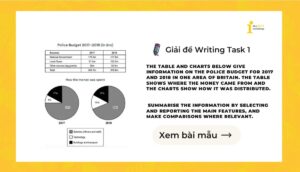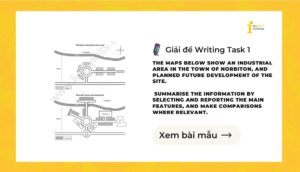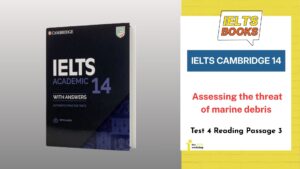Microplastics là bài nghe cuối cùng trong Cambridge 19 Test 3 Listening Part 4, thuộc dạng multiple choice và matching đòi hỏi thí sinh phải có kỹ năng nghe chọn lọc, nắm ý chính nhanh và xử lý thông tin chi tiết chính xác. Trong bài viết này, chúng ta sẽ cùng giải chi tiết từng câu hỏi và phân tích bẫy thường gặp để bạn học nâng cao kỹ năng Listening.
Đáp án IELTS Cambridge 19 Test 3 Listening Part 4
| Câu hỏi | Đáp án |
| 31 | clothing |
| 32 | mouths |
| 33 | salt |
| 34 | toothpaste |
| 35 | fertilizers |
| 36 | nutrients |
| 37 | growth |
| 38 | weight |
| 39 | acid |
| 40 | society |
Transcript và bản dịch chi tiết IELTS Cambridge 19 Test 3 Listening Part 4
| Transcipt | Bản dịch |
| In today’s lecture, I’m going to be talking about microplastics.Microplastics are tiny pieces of plastic smaller than five millimetres in size. Recently, there’s been a greater awareness that there are large quantities of plastic waste – both big and small – in the environment. The amount of plastic waste in the oceans has received widespread attention, but far less is known about the effects of microplastics in freshwater and particularly in soil. | Trong bài giảng hôm nay, tôi sẽ nói về vi nhựa.Vi nhựa là những mảnh nhựa rất nhỏ có kích thước dưới năm milimet. Gần đây, người ta ngày càng nhận thức rõ hơn rằng có một lượng lớn chất thải nhựa – cả to lẫn nhỏ – tồn tại trong môi trường. Lượng rác thải nhựa trong đại dương đã thu hút rất nhiều sự chú ý, nhưng tác động của vi nhựa trong nước ngọt và đặc biệt là trong đất thì ít được biết đến hơn. |
| Microplastics can enter the environment via a number of different sources. Threads and microfibres detach from synthetic clothing every time they’re put in a washing machine, and these find their way into the water system. Other sources include big pieces of plastic waste that are already in the environment, and these break down into microscopic particles over a period of time. On a larger scale, factory waste is another route, as are tyres which wear down as cars, lorries and so on travel along road surfaces. | Vi nhựa có thể xâm nhập vào môi trường qua nhiều nguồn khác nhau. Sợi vải và sợi siêu nhỏ tách ra từ quần áo tổng hợp mỗi lần chúng được giặt bằng máy, và những hạt này sẽ theo hệ thống nước thải ra môi trường. Các nguồn khác bao gồm các mảnh rác thải nhựa lớn đã tồn tại trong môi trường, bị phân hủy thành các hạt nhỏ li ti theo thời gian. Ở quy mô lớn hơn, chất thải từ các nhà máy và bụi mài mòn từ lốp xe khi xe di chuyển trên đường cũng là một nguồn phát sinh. |
| We already understand some of the impacts of microplastics from studies involving fish and other animals. There is evidence that microplastics harm small creatures in a variety of ways, such as by damaging their mouths, or by impairing their ability to feed, for example when microplastics get lodged in their digestive system.Surprisingly perhaps, it is likely that humans consume microplastics, as these have been detected in a wide range of food and drink products, including bottled water, as well as in water that comes direct from the tap. What’s more, salt and many kinds of seafood have also been found to contain microplastics. | Chúng ta đã hiểu phần nào về tác động của vi nhựa qua các nghiên cứu trên cá và những loài động vật khác. Có bằng chứng cho thấy vi nhựa gây hại cho các sinh vật nhỏ theo nhiều cách khác nhau, chẳng hạn như làm tổn thương miệng của chúng hoặc cản trở khả năng ăn uống, ví dụ khi các hạt vi nhựa mắc kẹt trong hệ tiêu hóa.Có lẽ bạn sẽ thấy ngạc nhiên, nhưng rất có khả năng con người cũng tiêu thụ vi nhựa, vì người ta đã phát hiện thấy chúng có mặt trong nhiều loại thực phẩm và đồ uống, bao gồm nước đóng chai, cũng như trong nước máy. Ngoài ra, muối và nhiều loại hải sản cũng được phát hiện có chứa vi nhựa. |
| However, it’s important to underline that there is not yet conclusive proof that microplastics cause significant harm to people. In many countries, including here in the UK, there is legislation which prevents manufacturers from adding plastic microbeads to shower gels, facial cleansers and toothpaste.It is very difficult to accurately estimate the total amount of microplastic particles in the soil as they can be hard to detect, but we do know they are carried in the air and deposited in the soil by rain. What’s more, many of the fertilisers used by both farmers and gardeners contain microplastics. | Tuy nhiên, cần nhấn mạnh rằng cho đến nay vẫn chưa có bằng chứng chắc chắn nào cho thấy vi nhựa gây hại nghiêm trọng cho con người. Ở nhiều quốc gia, bao gồm cả Vương quốc Anh, có luật ngăn cấm các nhà sản xuất cho thêm các hạt vi nhựa vào sữa tắm, sữa rửa mặt và kem đánh răng.Rất khó để ước lượng chính xác tổng lượng hạt vi nhựa có trong đất vì chúng rất khó phát hiện. Tuy nhiên, chúng ta biết rằng vi nhựa có thể bị gió cuốn đi và rơi xuống đất theo mưa. Hơn nữa, nhiều loại phân bón mà nông dân và người làm vườn sử dụng đều chứa vi nhựa. |
| A team from the Anglia Ruskin University in Cambridge has carried out a study of the effects of microplastics on the digestive tracts of earthworms. These worms, which live in topsoil, are an essential component of our agricultural system. By feeding on soil, they mix nutrients into it, thereby making it more fertile. | Một nhóm nghiên cứu từ Đại học Anglia Ruskin ở Cambridge đã tiến hành nghiên cứu về tác động của vi nhựa đối với đường ruột của giun đất. Những con giun này sống ở lớp đất mặt và là một phần thiết yếu trong hệ thống nông nghiệp của chúng ta. Chúng ăn đất và trộn chất dinh dưỡng vào đất, làm cho đất trở nên màu mỡ hơn. |
| The researchers set out to discover whether the introduction of microplastics into the soil – and the subsequent ingestion of these by earthworms – would impact soil quality and ultimately inhibit plant growth. The short answer was, yes, it did. After placing three different types of microplastic particles into the soil, they planted perennial rye grass. The particles of microplastic, which included biodegradable PLA and conventional high-density polyethylene, or HDPE, were then ingested by the earthworms in the soil. The result was that the worms lost weight rapidly. What’s more, a lower percentage than normal of the rye grass seeds germinated, and the researchers concluded that this was a direct result of the earthworms being unable to fulfil their normal role in making soil more fertile. The team also discovered that there was an increase in the amount of acid found in the soil, and this was attributed mainly to the microplastic particles from conventional HDPE plastic. | Các nhà nghiên cứu muốn tìm hiểu xem việc đưa vi nhựa vào đất – và việc giun đất ăn phải các hạt này – có ảnh hưởng đến chất lượng đất và cuối cùng là cản trở sự phát triển của thực vật hay không. Câu trả lời ngắn gọn là có. Sau khi đưa ba loại vi nhựa khác nhau vào đất, họ trồng cỏ rye lâu năm. Các hạt vi nhựa này, bao gồm PLA phân hủy sinh học và loại nhựa HDPE thông thường, sau đó được giun đất ăn vào. Kết quả là những con giun bị sụt cân nhanh chóng. Ngoài ra, tỷ lệ hạt giống cỏ nảy mầm cũng thấp hơn bình thường, và các nhà nghiên cứu kết luận rằng nguyên nhân là do giun đất không thể thực hiện chức năng bình thường là cải tạo đất. Nhóm nghiên cứu cũng phát hiện rằng lượng axit trong đất tăng lên, nguyên nhân chủ yếu là do các hạt vi nhựa từ nhựa HDPE. |
| The conclusions of the study make for very interesting reading – I’ve included the reference in the notes to give you at the end of this session. To summarise, the authors proposed the idea that we need to regard soil as we would regard any other process in nature. This means we should accept the implications of soil being dependent on decaying and dead matter constantly being passed through the bodies of earthworms. That is, when soil becomes impoverished by the presence of microplastics, not only ecosystems but also the whole of society are negatively impacted. | Kết luận của nghiên cứu này rất đáng chú ý – tôi đã đính kèm tài liệu tham khảo ở phần ghi chú để gửi các bạn sau buổi học. Tóm lại, các tác giả đề xuất rằng chúng ta cần xem đất như một quá trình tự nhiên. Điều này có nghĩa là chúng ta phải chấp nhận rằng đất phụ thuộc vào việc các chất hữu cơ phân hủy và xác động thực vật phải đi qua cơ thể của giun đất. Khi đất bị suy thoái do sự hiện diện của vi nhựa, không chỉ hệ sinh thái mà cả toàn xã hội đều bị ảnh hưởng tiêu cực. |
Phân tích chi tiết đáp án Cambridge 19 Test 3 – Listening Part 4
Question 31
Đáp án: clothing
Transcript: Threads and microfibres detach from synthetic clothing every time they’re put in a washing machine, and these find their way into the water system.
Phân tích: Vi nhựa có thể xâm nhập môi trường từ sợi nhỏ của quần áo khi được giặt bằng máy. Những từ như “fibres”, “washing”, “synthetic clothes” đều dẫn đến đáp án là clothing.
Gợi ý trong bài: “Threads and microfibres” gợi ý rằng các sợi vi nhựa tách ra từ quần áo tổng hợp mỗi khi giặt, cho thấy nguồn phát sinh vi nhựa là từ quần áo.
Question 32
Đáp án: mouths
Transcript: There is evidence that microplastics harm small creatures in a variety of ways, such as by damaging their mouths, or by impairing their ability to feed, for example when microplastics get lodged in their digestive system.
Phân tích: Vi nhựa được nhắc đến là gây tổn thương đến miệng của các loài vật nhỏ trong tự nhiên. Từ mouths là danh từ phù hợp.
Gợi ý trong bài: “Damaging the mouths of small creatures” cho thấy miệng là bộ phận chịu ảnh hưởng từ vi nhựa.
Question 33
Đáp án: salt
Transcript: What’s more, salt and many kinds of seafood have also been found to contain microplastics.
Phân tích: Ngoài nước đóng chai và nước máy, muối cũng được đề cập là có chứa vi nhựa. Điều này làm rõ rằng salt là một phần trong chuỗi thực phẩm của con người bị ảnh hưởng.
Gợi ý trong bài: Cụm “bottled water”, “tap water”, “food”, “seafood” đều nhấn mạnh sự hiện diện của vi nhựa trong thực phẩm và đồ uống.
Question 34
Đáp án: toothpaste
Transcript: In many countries, including here in the UK, there is legislation which prevents manufacturers from adding plastic microbeads to shower gels, facial cleansers and toothpaste.
Phân tích: Bên cạnh sữa tắm và sữa rửa mặt, kem đánh răng cũng bị cấm thêm vi nhựa ở nhiều quốc gia, như được nêu rõ trong đoạn nói. Do đó, đáp án là toothpaste.
Gợi ý trong bài: “Shower gels”, “facial cleansers”, và “banned from being added to” nhấn mạnh vào các sản phẩm bị cấm chứa vi nhựa.
Question 35
Đáp án: fertilizers
Transcript: What’s more, many of the fertilisers used by both farmers and gardeners contain microplastics.
Phân tích: Một trong những cách microplastics đi vào đất là thông qua phân bón được sử dụng trong nông nghiệp và làm vườn. Vì vậy đáp án là fertilizers.
Gợi ý trong bài: “Carried in the air”, “by rain”, và “used by farmers” cho thấy các con đường vi nhựa thâm nhập vào đất.
Question 36
Đáp án: nutrients
Transcript: By feeding on soil, they mix nutrients into it, thereby making it more fertile.
Phân tích: Giun ăn và trộn các chất dinh dưỡng vào đất, giúp tăng độ màu mỡ. Từ phù hợp để điền là nutrients.
Gợi ý trong bài: “Worms”, “essential”, “mix into the soil” làm rõ giun cung cấp chất gì cho đất.
Question 37
Đáp án: growth
Transcript: The researchers set out to discover whether the introduction of microplastics into the soil – and the subsequent ingestion of these by earthworms – would impact soil quality and ultimately inhibit plant growth.
Phân tích: Vi nhựa trong giun đất có thể ảnh hưởng xấu đến sự tăng trưởng của cây. Do đó, từ cần điền là growth.
Gợi ý trong bài: “Impact the growth of plants” cho thấy yếu tố bị ảnh hưởng bởi vi nhựa trong đất là sự phát triển của cây trồng.
Question 38
Đáp án: weight
Transcript: The result was that the worms lost weight rapidly.
Phân tích: Việc giun sụt cân nhanh chóng sau khi tiếp xúc với vi nhựa được nêu rõ trong bài, do đó đáp án là weight.
Gợi ý trong bài: “Lost weight rapidly” nêu rõ điều gì bị giảm ở giun đất.
Question 39
Đáp án: acid
Transcript: The team also discovered that there was an increase in the amount of acid found in the soil, and this was attributed mainly to the microplastic particles from conventional HDPE plastic.
Phân tích: Tác động của microplastics dẫn đến việc gia tăng acid trong đất, vì vậy đáp án phù hợp là acid.
Gợi ý trong bài: “An increase in the amount of acid in the soil” chỉ ra yếu tố tăng lên trong đất do ảnh hưởng của vi nhựa.
Question 40
Đáp án: society
Transcript: That is, when soil becomes impoverished by the presence of microplastics, not only ecosystems but also the whole of society are negatively impacted.
Phân tích: Khi đất bị suy thoái do vi nhựa, toàn bộ xã hội cũng bị ảnh hưởng chứ không chỉ riêng hệ sinh thái. Vì vậy đáp án là society.
Gợi ý trong bài: “The whole of society” cho thấy mức độ ảnh hưởng vượt ngoài hệ sinh thái.
Series giải đề IELTS Cambridge 19
- [PDF + Audio] Trọn bộ Cambridge IELTS 1 – 20 mới nhất
- [PDF + Audio] Sách IELTS Cambridge 19
- Đáp án Cambridge 19 & Lời giải chi tiết: Test 1 – Test 4
- Giải IELTS Cambridge 19 Test 3 Listening Part 1: Local food shops
- Giải IELTS Cambridge 19 Test 3 Listening Part 2: Festival Workshops
- Giải IELTS Cambridge 19 Test 3 Listening Part 3: Listening Science experiment for Year 12 students
- Giải IELTS Cambridge 19 Test 3 Listening Part 4: Listening Listening Microplastics
- Giải Cambridge IELTS 19 Test 3 Reading Passage 1: Archaeologists discover evidence of prehistoric island settlers
- Giải Cambridge IELTS 19 Test 3 Reading Passage 2: The global importance of wetlands
- Giải Cambridge IELTS 19 Test 3 Reading Passage 3: Is the era of artificial speech translation upon us?
Tham gia khoá học IELTS miễn phí của The IELTS Workshop cùng đội ngũ giảng viên 9.0 để nâng cao toàn diện kỹ năng làm bài thi IELTS và ôn luyện theo lộ trình cá nhân hoá!

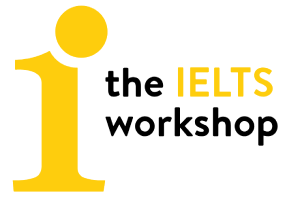
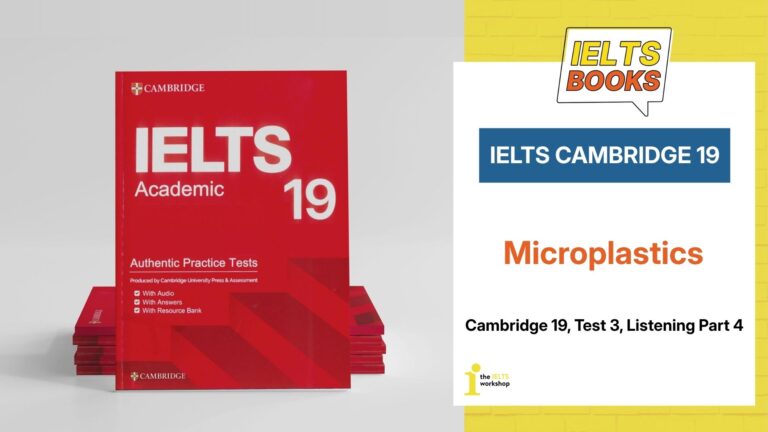
![[PDF + Audio] Trọn bộ Cambridge Practice Tests For IELTS 1 – 20 mới nhất](https://onthiielts.com.vn/wp-content/uploads/2020/04/cam-1-14-764x400.jpg)
![[PDF + Audio] Cambridge IELTS 20: Cập nhật mới nhất (Bản đẹp)](https://onthiielts.com.vn/wp-content/uploads/2025/07/Cambridge-IELTS-20-300x169.jpg)
